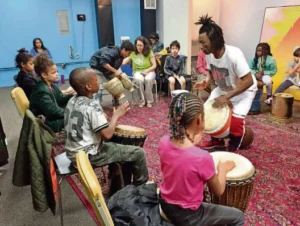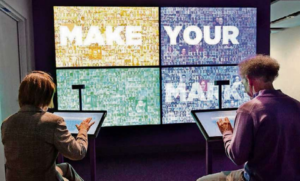
An African drumming and dance workshop at the International Peace Museum
 Holocaust Museum visitors become part of the experience on this “Make Your Mark” interactive photo wall, which encourages reflection and action based on what you’ve learned.
Holocaust Museum visitors become part of the experience on this “Make Your Mark” interactive photo wall, which encourages reflection and action based on what you’ve learned.
Area museums educate and inspire.
Here’s a New Year’s Resolution that won’t require a trip to the gym or calorie counting.
Why not pledge to help counteract the hatred and prejudice that are giving rise to increasing hate crimes in our own country and around the world? And why not learn more about making peace? We’re fortunate to have two museums in our immediate area that can help educate us on these important topics. The Dayton International Peace Museum is America’s only brick-and-mortar peace museum with the important goal of teaching people — especially children — nonviolent approaches to conflict resolution.
Cincinnati’s newest museum — the Holocaust & Humanity Center at Union Terminal — aims at using the lessons of the Holocaust to inspire action today.
“One of the lessons of the Holocaust is that we must not be bystanders,” says the museum’s executive director, Sarah Weiss. “The museum is designed to empower visitors to realize that each of us has the potential to become upstanders and make a difference in our world. The museum experience is designed to encourage visitors to explore how they can activate their strengths to become an upstander, someone who recognizes when something is wrong and acts to make it right.”
More about the Peace Museum Dayton’s museum, founded in 2004, honors the 1995 Dayton Peace Accords that ended war in Bosnia. Its mission is to inspire a local, national, and international culture of peace.
“The new year provides an opportunity to reevaluate what worked and what set us back as a family, a community, and as a nation,” says executive director Kevin Kelly. ” Certainly, many people in the Miami Valley were impacted by tragedies we often looked at before as happening in other places. Gun violence, racism and the climate crisis came to roost in Dayton this year and few of us were well-prepared for those things happening in our own back yard. Our sense of safety and order was challenged.”
The Dayton Peace Museum’s motto is “A Space to Make Peace.” “We literally mean that,” says Kelly.
“We offer free mediation, yoga, a children’s summer camp, a new program for teens to learn how to be peacebuilders in their communities, and quarterly exhibits and receptions.”
The museum’s board chair, Mary Ramey, says the museum is a good place to stop and chat with people who are interested in exploring our commonalities rather than focusing on our differences.
She is especially excited about the newest exhibit, the only permanent educational exhibit on the Dayton Peace Accords. “You can read the wall panels and get a good idea of the history or you could spend hours with the interactive touch screens.”
Ramey’s favorite exhibit is the quilt labyrinth by Janet Bear McTavish which features 20 different religions. “At the core of the 20 religions is the same principle,” she says. “Treat others as you would like to be treated.”
The museum’s children’s room has activities families can do together.
The museum has four special exhibitions each year; at the moment there’s an exhibit on Yemen featuring photos by local photojournalists and artwork by Yemeni schoolchildren. The powerful Dayton Strong exhibit features photos by Whitney Saleski.
Future Plans for the Peace Museum
Kelly says in the new year, the Peace Museum plans to offer live music on downtown Dayton’s First Fridays, a monthly Peace Builder speaker series from fresh but often controversial viewpoints on every side, opportunities to join a book club that focuses on human rights and justice topics, discussions and films on recent events, and opportunities to serve the Dayton community.
“People need to connect, even if they don’t agree on every issue,” he says. “The politically left and right must find common ground and stop judging each other’s entire being by the fact they see current politics differently.
Many of us have lost friends over these divisions or no longer talk to members of our own family. I believe the most important way to mitigate this recent trend is to meet it with kindness and directness.”
While the Dayton Peace Museum will continue to operate as a museum, it has broadened its mission to include outreach and support for the community by offering space and resources. In 2020, the museum will offer an eight-week course in cultivating compassion from a program developed at Stanford University, a weeklong summer teacher’s workshop on peace literacy led by nationally known and respected peace advocate Paul Chappelle of the Nuclear Peace Age Foundation, several collaborations with
the Wright State theater and motion picture department, a children’s summer camp in June plus the annual Nobel Peace Prize event in November.
“Getting involved as an active volunteer, connecting and working for justice, either at the museum, or wherever feeds your soul, is a terrific start to a more peaceful new year,” Kelly says.
About the Holocaust Museum
The new 7,500-square-foot, state-of-the-art Holocaust Museum is surrounded by a complex of terrific museums at Cincinnati’s historic Union Terminal. While you’re visiting, you can also check out the Omnimax Theater, Duke Energy Children’s Museum, Museum of Natural History and Science, and the Cincinnati History Museum.
Through innovative storytelling, interactive experiences, and genuine artifacts, visitors witness the strength and courage of the human spirit set against the backdrop of one of history’s darkest chapters. In the Humanity Gallery, visitors are introduced to courageous people who have worked toward making positive changes in the world.
Although there are a number of Holocaust museums in the United States, Cincinnati is the only one housed in an authentic place related to history; it was the first stop for more than 2,000 Holocaust survivors who came to Cincinnati after the war.
“We’ve always thought of trains related to the Holocaust as trains of destruction, trains to death,” Weiss has said. “But we have the opportunity — this duality of history — to talk about trains to freedom and trains to the future and trains of hope.”
You’ll hear the personal stories of many of those survivors, including David Hochstein, a well-known Dayton furrier whose mother and father were both murdered by the Nazis. “I never thought that the day I boarded the train would be the last time I saw my parents,” Hochstein told the museum. “The last words my father spoke to me were, ‘Never forget that you are a Jew.’”
In addition to Holocaust survivors, you’ll learn about many “upstanders” — such as journalist Ed Vulliamy, who brought attention to the Bosnian Muslims who were abducted, forced into concentration camps, beaten, raped and murdered as part of an ethnic cleansing campaign by Bosnian Serb forces in the 1990s. Another upstander is 10-year-old Mirsada Kadiric, who survived the Trnopolje concentration camp during that war.
Her father was murdered in Omarska, a concentration camp in Bosnia. After the war, Mirsada and her mother eventually settled near Cincinnati, where she volunteered with RefugeeConnect, an organization supporting refugees and victims of genocide.
The museum also highlights the Dayton Accords peace agreement, signed at Wright-Patterson Air Force Base, which ended the war in November 1995.
Should children visit?
You may be wondering if a Holocaust museum is appropriate for children.
Weiss says parents should determine if the subject matter is age appropriate for their children. The museum recommends ages 11 and up, but parents should take into consideration the emotional maturity of their children.
“If one decides it’s appropriate, it would be best to have a discussion and determine what they know about the Holocaust and how they know it,” Weiss suggests. Is their knowledge based on a film or book? Have they met a Holocaust survivor? You can have a conversation about how the Holocaust fits into history and talk about the museum as both an educational and memorial space. Encourage them to ask questions before their visit, look for a story or person that touches them when they go through the museum and let them ask questions during and after the visit.
“Sadly the current environment of hate and extremism has provided relevance and meaning to the opening of this new museum,” says Weiss. “In light of current events, we have seen an increased outpouring of passion and support for this endeavor, which shows us how important a museum like this is to our community.”
What else can we do?
Michael Lieberman, Washington Counsel for the Anti-Defamation League, was one of the staffers charged with helping ADL craft an appropriate response to Charlottesville, to the Tree of Life murders, to the attack and murder at the Poway Chabad and after 22 people were killed in El Paso by a man targeting Hispanics.
“In each case, we determined that the very most important response would be to have responsible leaders speak out against anti-Semitism and against all forms of bigotry and hate,” he says.
“Especially at this deeply divided, deeply dangerous time, every person can change their own worlds, their spheres of influence — their communities, their friends, their families – to encourage them to stand up against those being targeted for discrimination and bullying and to speak out against hate.”
Contact this reporter at 937- 225-2440 or email Meredith.
Moss@cmg.com.
OTHER WAYS TO GET INVOLVED
■ Attend community cultural festivals and have your children sample food, the arts, and traditions of other cultures. Some examples: The Hispanic Festival, the Jewish Cultural Festival, Greek Fest, Dayton Celtic Festival, Dayton Lebanese Festival.
■ Visit a house of worship workshop other than your own. own. Ask questions!
■ Don’t miss A World A’Fair, the three-day international festival held each May at the Dayton Convention Center. It’s a wonderful opportunity for families to learn more about other cultures and countries.
■ Ask your librarian to recommend books for both adults and children. This year’s non-fiction Dayton Literary Peace Prize winner is “Rising Out of Hatred: The Awakening of a Former White Nationalist” by Eli Saslow. Another book of the moment is “How to Be An Anti-Racist” by Ibram X. Kendi.
■ Attend “Reach Across Dayton,” the all-day conference at Sinclair Community College. This year’s event is slated for Friday, Feb. 28. It’s designed to “promote learning in the arts and humanities by creating an atmosphere that builds respect, knowledge, appreciation, and understanding for this area’s diverse cultural populations.” This year’s theme: “In the Spirit of Celebrating All Our Stories.”
■ Get involved with area organizations such as Cross Over Community Development. The nonprofit organization was created in 2016 to support immigrants, asylees, and refugees. To learn more about this group, check out our Make a Difference column in the Neighbors section of the Dayton Daily News on Thursday, Jan. 2.



